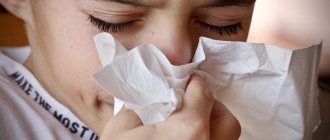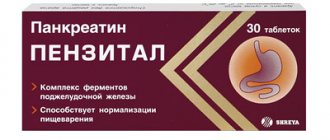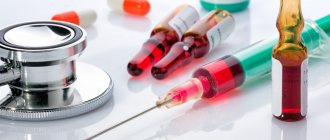Compound
Active ingredients per sachet: paracetamol (acetaminophen) 160 mg, ascorbic acid 50 mg, chlorpheniramine maleate 1 mg. Excipients : citric acid 50 mg, Red charming dye 0.05 mg, raspberry flavor 100 mg, colloidal silicon dioxide (syloid) 4 mg, silicon dioxide 20 mg, sodium citrate dihydrate 2 mg, corn starch 1 mg, powdered sugar 2794, 95 mg, sucrose 8800 mg, titanium dioxide 1 mg, calcium phosphate 1 mg.
general information
Antiflu Kids belongs to the group of combined anti-inflammatory and analgesic drugs. INN – Antiflu Kid's. Used in pediatric and therapeutic practice.
Dosage form, cost, composition
Antiflu is a white powder for preparing a drink taken orally. 1 package may contain 5 or 8 sachets. The price of Antiflu Kids is shown in the table.
| № | Number of sachets per package | average price |
| 1. | 5 sachets | From 206 rubles |
| 2. | 8 sachets | From 229 rubles |
The drug contains 3 active ingredients:
- paracetamol;
- ascorbic acid;
- chlorpheniramine maleate.
After the powder dissolves, the resulting drink turns pink. The drug is made with the addition of raspberry flavor.
Pharmacological features
Due to the content of 3 active components, the medicine has a versatile therapeutic effect:
Analgesic, antipyretic. This effect is exerted by the non-steroidal anti-inflammatory component paracetamol. In parallel, its use achieves a mild anti-inflammatory effect.- Immunostimulating. Ascorbic acid has the ability to strengthen and activate the immune system to fight infections and viruses. Under its influence, the tolerance of paracetamol by the patient's body significantly improves.
- Antiallergic, antihistamine effect. Chlorphenamine - blocks H1-histamine receptors, thereby eliminating lacrimation, sneezing, rhinitis, itching of the eyes and nose.
The interaction of the components of the medication allows you to get rid of fever, runny nose, sore throat, and cephalgia. The medication partially reduces muscle pain and joint aches. There is no information on the pharmacokinetics of the drug in question.
Contraindications
Hypersensitivity to individual components of the drug, severe dysfunction of the liver (Child-Pugh > 9) and kidneys, sucrase/isomaltase deficiency, fructose intolerance, glucose-galactose malabsorption, children under 2 years of age. When combined with monoamine oxidase inhibitors (MAOIs). MAO inhibitors should not be used in combination with antihistamines due to potential side effects on the central nervous system. These effects may prolong and exacerbate the anticholinergic effects of antihistamines.
Carefully
Arterial hypertension, severe cardiovascular diseases, moderate liver and kidney dysfunction, diabetes mellitus, glaucoma, bronchial asthma, chronic obstructive pulmonary disease, thyrotoxicosis, pheochromocytoma, difficulty urinating with prostate adenoma, blood diseases, congenital hyperbilirubinemia (Gilbert, Dubin syndromes) -Johnson and Rother), hyperoxalaturia, glucose-6-phosphate dehydrogenase deficiency, epilepsy, pyloroduodenal obstruction, alcoholism. If you have such conditions, you should consult your doctor before use.
Directions for use and doses
Inside. A single dose for children 2-5 years old is the contents of 1 sachet, for children 6-12 years old - the contents of 2 sachets. Take orally, regardless of food intake, after dissolving in 100-200 ml of warm water (not boiling). If necessary, repeat the dose every 4-6 hours, but no more than 4 sachets per day. If the temperature does not decrease, the pain, chills, and runny nose do not stop, be sure to consult a doctor. The drug should not be taken for more than 3 days without consulting a doctor. Further therapy is possible after consultation with a specialist.
Detailed instructions for taking the medication
The instructions for Antiflu Kids note that the medicine can be taken regardless of food. The course of therapy is usually 5 days. Before taking, the powder contained in 1 sachet should be completely dissolved in 150 ml of boiled warm (not hot) water. The dosing features of the medication are as follows:
- Children 2-5 years old: 1 sachet three times a day.
- Children 6-12 years old: 2 sachets once a day.
Release forms and dosages
The interval between doses should be from 4 to 6 hours. Do not use the drug for more than 5 days. If it is not possible to achieve the expected results from therapy, it is necessary to stop treatment and consult a specialist for further instructions.
Antiflu Kids is not recommended to be taken in parallel with sleeping pills and sedatives. Also, you should not combine this remedy with medications made on the basis of ethanol alcohol. You should avoid taking Antiflu for children together with other medications related to NSAIDs or combined anti-inflammatory/painkillers.
The drug contains sugar as an excipient. Less commonly reported is the development of hypersensitivity reactions in patients. They were manifested by a rash, skin itching, angioedema, and urticaria. If such deviations occur, therapy must be discontinued.
Such conditions, as a rule, do not require specific therapeutic measures. But sometimes a child may need to take antiallergy medications to eliminate allergy symptoms.
During treatment, you must refrain from taking tests for glucose, uric acid, bilirubin, AST and ALT. Ascorbic acid in combination with paracetamol may distort laboratory results.
Important! If the temperature does not go down within 3 days, or the pain does not go away within 5 days from the start of using the drug, its further use is inappropriate. In such circumstances, consultation with a pediatrician or family doctor will be mandatory.
Side effect
Allergic reactions: skin rash, itching, urticaria, toxic epidermal necrolysis (Lyell's syndrome), polymorphobullous erythema (Stevens-Johnson syndrome), acute generalized exanthematous pustulosis, angioedema (Quincke's edema), anaphylactic shock. From the central nervous system: dizziness, sleep disturbance (drowsiness), headache, excitability, decreased speed of psychomotor reactions, fatigue, disorientation, anxiety, convulsions, movement disorder, confusion, coma. From the hematopoietic system: anemia, thrombocytopenia, thrombocytopenic purpura, leukopenia, pancytopenia, agranulocytosis, hemolytic anemia, methemoglobinemia. From the digestive system: nausea, vomiting, stomach discomfort, abdominal pain, diarrhea, dry mouth, loss of appetite Disorders from the liver and biliary tract: liver damage (increased activity of “liver” enzymes), hepatitis, as well as dose-dependent liver failure, liver necrosis. Long-term unjustified use can lead to liver fibrosis and liver cirrhosis. From the urinary system: urinary retention, with long-term use of high doses nephrotoxic effect. Respiratory disorders: bronchospasm or exacerbation of bronchial asthma, including in patients sensitive to acetylsalicylic acid or other NSAIDs. Endocrine system disorders: hypoglycemia. Cardiovascular system disorders: tachycardia, increased blood pressure, arrhythmia, angina pectoris. Visual disturbances: visual disturbances, accommodation disturbances, dry eyes, dilated pupils; increased intraocular pressure.
Manifestations of side effects and signs of overdose
Often, undesirable effects when taking a medication manifest themselves through the occurrence of the following symptoms:
- nausea;
- diarrhea;
- gastralgia;
- vomit;
- abdominal pain;
anemia;- thrombocytopenia;
- pancytopenia;
- leukopenia;
- agranulocytosis;
- cephalgia;
- vertigo;
- insomnia;
- increased psycho-emotional or physical arousal;
- drowsiness;
- feeling very tired;
- retardation of psychomotor reactions;
- liver dysfunction;
- development of toxic hepatitis;
- problems with urination;
- bronchospasm;
- Quincke's edema;
- anaphylactic shock (in severe cases);
- increased intraocular pressure, etc.
But usually the medicine is tolerated quite well by children.
To avoid side effects, before starting therapy, it is recommended to test the sensitivity of the child’s body to the components of the drug.
The occurrence of symptoms of a drug overdose requires immediate medical attention. Using the medicine in high doses can lead to serious problems with the liver and kidneys. Mental disorders, disturbances of consciousness, development of comatose states and even death are possible.
If signs of overdose appear, the drug should be stopped immediately. The doctor will provide symptomatic therapy if necessary. If such measures are not enough to stabilize the patient’s condition, measures will be taken to ensure forced diuresis.
Overdose
In case of overdose, you should immediately seek medical help. Paracetamol Symptoms: diarrhea, loss of appetite, nausea and vomiting, abdominal discomfort and/or abdominal pain, increased sweating. The clinical picture of an acute overdose of paracetamol develops within 6-14 hours after taking paracetamol. Symptoms of chronic overdose appear 2-4 days after increasing the dose of the drug. In cases of severe poisoning, severe liver failure may occur, including hepatic encephalopathy, coma and death. Hypokalemia and metabolic acidosis (including lactic acidosis) can also develop in conditions of acute and/or chronic overdose. Frequent clinical manifestations after 3-5 days are jaundice, fever, hepatic breath, hemorrhagic diathesis, hypoglycemia, and liver failure. Acute renal failure with acute tubular necrosis, which is diagnosed by severe pain in the lumbar region, hematuria and proteinuria, can develop without severe impairment of liver function. Treatment: gastric lavage, activated carbon in the first 6 hours, administration of SH-group donors and precursors for the synthesis of glutathione - methionine 8-9 hours after an overdose and N-acetylcysteine after 12 hours.
Chlorpheniramine Symptoms: dizziness, agitation, sleep disturbances, depression, seizures and coma. Treatment: symptomatic.
Ascorbic acid High doses of ascorbic acid (more than 3000 mg) can cause temporary osmotic diarrhea and gastrointestinal disturbances, such as nausea and stomach discomfort. Treatment: symptomatic, forced diuresis.
Interaction with other drugs
It is not recommended to take simultaneously with sleeping pills, sedatives and drugs containing alcohol. Increases the concentration of benzylpenicillin and tetracyclines in the blood. Improves the absorption of iron preparations in the intestines (converts ferric iron to divalent iron); may increase iron excretion when used concomitantly with deferoxamine. Increases the risk of developing crystalluria during treatment with salicylates and short-acting sulfonamides, slows down the excretion of acids by the kidneys, increases the excretion of drugs that have an alkaline reaction (including alkaloids), and reduces the concentration of oral contraceptives in the blood. Increases overall ethanol clearance. When used simultaneously, it reduces the chronotropic effect of isoprenaline. Reduces the therapeutic effect of antipsychotic drugs (neuroleptics) - phenothiazine derivatives, tubular reabsorption of amphetamine and tricyclic antidepressants. Reduces the effectiveness of uricosuric drugs. It can either increase or decrease the effect of anticoagulant drugs. Paracetamol (or its metabolites) interacts with enzymes involved in vitamin K-dependent clotting factor synthesis. Interactions between paracetamol and warfarin or coumarin derivatives may result in an increase in the international normalized ratio (INR) and an increased risk of bleeding. Patients taking oral anticoagulants should not take paracetamol for long periods of time without medical supervision. Ethanol enhances the sedative effect of chlorphenamine. Antidepressants, antiparkinsonian and phenothiazine antipsychotic drugs increase the risk of side effects (urinary retention, dry mouth, constipation). Glucocorticosteroids increase the risk of developing glaucoma. Inducers of microsomal oxidation in the liver (phenytoin, ethanol, barbiturates, rifampicin, phenylbutazone, tricyclic antidepressants) increase the production of hydroxylated active metabolites of paracetamol, which makes it possible to develop severe hepatotoxic reactions even with a small overdose. Inhibitors of microsomal oxidation (including cimetidine) reduce the risk of hepatotoxic action of paracetamol. Diflunisal increases the plasma concentration of paracetamol by 50% and increases hepatotoxicity. Ethanol reduces the concentration of ascorbic acid in the body and also contributes to the development of acute pancreatitis. The use of barbiturates reduces the effectiveness of paracetamol and increases the excretion of ascorbic acid in the urine. Strengthens the effect of sleeping pills. When used simultaneously with chloramphenicol, it is possible to increase its half-life from blood plasma and increase the toxic effect. Medicines that cause delayed gastric emptying, such as propantheline, may result in delayed absorption of paracetamol and thus delay the onset of action. Medicines that cause gastric emptying faster, such as metoclopramide, may cause paracetamol to be absorbed more quickly and thus speed up the onset of action. Tropisetron and granisetron, 5-hydroxytryptamine type 3 antagonists, can completely inhibit the analgesic effect of paracetamol through pharmacodynamic interaction. Paracetamol should not be taken together with zidovudine without the advice of a doctor due to an increased tendency to decrease the number of white blood cells (neutropenia). Continuous combination therapy with more than one analgesic should be avoided; due to possible additive side effects. Monoamine oxidase inhibitors (MAOIs) should not be taken in combination with antihistamines (eg, chlorphenamine maleate) due to possible additive CNS depressant effects. These effects may prolong and exacerbate the anticholinergic effects of antihistamines.
Antiflu Kids por d/ra vn approx 12 g x5
Trade name: AntiFlu Kids International name: Paracetamol+Chlorphenamine+Ascorbic acid
Release form: powder for the preparation of solution for oral administration (laminated aluminum foil bags) 12 g
Ingredients: ascorbic acid 50 mg, paracetamol 160 mg, chlorphenamine maleate 1 mg
Pharmacological group: acute respiratory infections and “cold” symptoms remedy (analgesic non-narcotic drug + H1-histamine blocker + vitamin)
Pharmacological group according to ATK: N02BE51 (Paracetamol in combination with other drugs (excluding psychotropic drugs))
Pharmacological action: H1-histamine-blocking, antihistamine, vitamin, antipyretic, sedative, cold and flu, eliminating symptoms, analgesic,
Indications: Flu, ARVI, acute rhinitis - symptomatic treatment.
Directions for use and dosage:
A single dose for children 2-5 years old is 1 sachet, for children 6-12 years old - 2 sachets. Take orally, regardless of meals, after dissolving the contents of the package in 150 ml of warm water.
Special instructions:
If necessary, repeat the dose every 4-6 hours, but no more than 3 doses per day. The total duration of treatment should not exceed 5 days. Further use is possible only under medical supervision.
Contraindications:
Increased individual sensitivity to the components of the drug, severe impairment of liver and/or kidney function.
Drug interactions: It is not recommended to take simultaneously with sleeping pills, sedatives and drugs containing alcohol.
Release form: Powders, 5 pcs. in cardboard packaging.
Side effects: In isolated cases, the following occur: From the central nervous system: headache, feeling of fatigue. From the gastrointestinal tract: nausea, epigastric pain. From the endocrine system: hypoglycemia (up to the development of coma). From the hematopoietic organs: anemia, hemolytic anemia (especially for patients with glucose-6-phosphate dehydrogenase deficiency), extremely rarely - thrombocytopenia. Allergic reactions: anaphylactoid reactions (including anaphylactic shock). From the skin: itching, rash on the skin and mucous membranes (usually erythematous, urticaria), angioedema, exudative erythema multiforme (including Stevens-Johnson syndrome), toxic epidermal necrolysis (Lyell's syndrome). Other: hypervitaminosis, metabolic disorders, feeling of heat, drowsiness.
Overdose. Paracetamol. Symptoms: diarrhea, loss of appetite, nausea and vomiting, abdominal discomfort and/or abdominal pain, increased sweating. The clinical picture of an acute overdose of paracetamol develops within 6-14 hours after taking paracetamol. Symptoms of chronic overdose appear 2-4 days after increasing the dose of the drug.
Chlorphenamine. Symptoms: dizziness, agitation, sleep disturbances, depression, seizures and coma. Treatment: symptomatic.
Pharmacodynamics: Combined drug. Paracetamol has an analgesic and antipyretic effect. Chlorphenamine (H1-histamine receptor blocker) has an antiallergic effect and reduces swelling of the mucous membrane of the upper respiratory tract. Ascorbic acid normalizes capillary permeability, has an antioxidant effect, and helps increase the body's resistance.
Interaction: Increases the concentration of benzylpenicillin and tetracyclines in the blood. Improves the absorption of iron preparations in the intestines (converts ferric iron to divalent iron), can increase the excretion of iron when used simultaneously with deferoxamine. Increases the risk of developing crystalluria during treatment with salicylates and short-acting sulfonamides, slows down the excretion of acids by the kidneys, increases the excretion of drugs that have an alkaline reaction (including alkaloids), and reduces the concentration of oral contraceptives in the blood. Increases overall ethanol clearance. When used simultaneously, it reduces the chronotropic effect of isoprenaline. Reduces the therapeutic effect of antipsychotic drugs (neuroleptics) - phenothiazine derivatives, tubular resorption of amphetamine and tricyclic antidepressants. Reduces the effectiveness of uricosuric drugs. It can either increase or decrease the effect of anticoagulant drugs. Inducers of microsomal oxidation in the liver (phenytoin, ethanol, barbiturates, rifampicin, phenylbutazone, tricyclic antidepressants) increase the production of hydroxylated active metabolites of paracetamol, which makes it possible to develop severe hepatotoxic reactions even with a small overdose. Inhibitors of microsomal oxidation (including cimetidine) reduce the risk of hepatotoxic action of paracetamol. Diflunisal increases the plasma concentration of paracetamol by 50% and increases hepatotoxicity. Ethanol reduces the concentration of ascorbic acid in the body and also contributes to the development of acute pancreatitis. The use of barbiturates reduces the effectiveness of paracetamol and increases the excretion of ascorbic acid in the urine. Strengthens the effect of sleeping pills.
Dispensed from pharmacies: Dispensed without a prescription.
Drug registration number: LS-000415
Date of registration (re-registration) of the drug: 07/01/2005
special instructions
Given the drug’s ability to cause drowsiness, children should be freed from activities that require increased concentration for 4 hours after taking the drug. Contains natural sugar. Each sachet contains 1 XE. Very rare cases of serious skin reactions have been reported. If your skin turns red, rashes, blisters or peels, you should stop using paracetamol and consult a doctor immediately. Paracetamol and ascorbic acid can distort laboratory test results (quantitative determination of glucose and uric acid in plasma, bilirubin, liver transaminase activity, LDH). For hyperthermia lasting more than 3 days and pain for more than 5 days, a doctor’s consultation is required. Avoid combined use with other medications aimed at the symptomatic treatment of colds and flu, as well as with medications containing paracetamol or antihistamines. Do not exceed the recommended dose and duration of treatment.
Analogs
Drug substitutes can be divided into 2 groups:
- by composition;
- according to the principle of impact on the body.
The first group includes:
- Antigrippin. Effervescent tablets of round shape are quite large in size. Children under 5 years of age are recommended to dissolve half a tablet in a glass of warm boiled water. Reception is carried out 2 times a day. Children from 5 to 10 years old – 1 tablet twice a day. Adolescents 1115 years old - 1-2 tablets at a time, twice a day. The course of therapy is 5 days.
Fervex for children. Another drug available in powder form for preparing a warm drink. The active ingredients are the same as those of Antiflu Kids. The drug is approved for use in children over 6 years of age.- Efferalgan with vitamin C. The basis of the medicine is ascorbic acid in combination with paracetamol. The drug is dispensed in the form of effervescent tablets. The principle of their use is identical to Antigrippin. However, this medicine is approved for use by children over 8 years of age.
- Coldrex Junior Hot Drink. Powder for preparing a hot drink contains the active ingredients paracetamol, phenylephrine and ascorbic acid. The medicine is indicated for children over 6 years of age.
If we talk about drugs that have a similar mechanism of action, these include Panadol, Paracetamol, Ibufen, Ibunorm, Nurofen, Gofen. All of these products are available in the form of syrups, tablets or oral suspensions. Despite the difference in composition (compared to Antiflu Kids), these medications have the same therapeutic effect - analgesic, antipyretic and anti-inflammatory.




